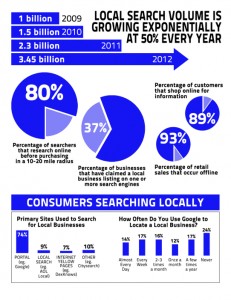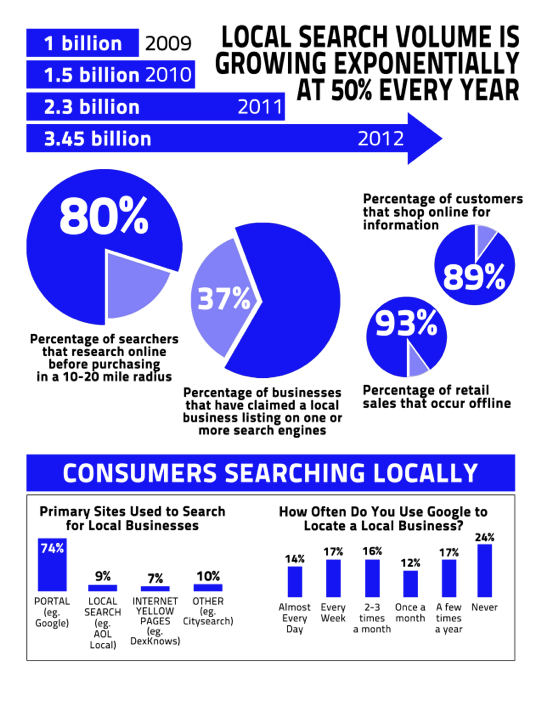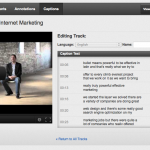Small Business Local SEO Guide

Small Business Local SEO is more important than ever. Local Searches (with geo-modifiers) now take up a full 20% of all searches performed on the internet. That’s over 3 billion searches each month that use a local term like a city name or region. That doesn’t even count localized results for generic terms like “plumber.” (Notice all those listings for plumbers in your area?) It’s not unreasonable to think that following the Google updates of the last 2 years, 40% or more of all searches are returning local results. That means there are 6 billions searches each month by potential customers seeking out something in their local area.
Surprising Data on Small Business Local SEO:
- 97% of internet users gather information online before buying. (Source)
- 60% of activity online is one way or another “related to local content” (Google May 2003)
- For every one dollar U.S. consumers spend online, another five or six are going to offline purchases that are influenced by online research (MIT Technology Review, April 2005, “E-Commerce Gets Smarter“)
- 25% of ALL commercial Internet searches are conducted by users looking for local merchants (Kelsey-Bizrate 2004)
- A 2011 study by MIT showed that after 12 months of marketing online, business experienced an average 32 percent increase in leads month-to-month. That’s a 32% increase in leads every month.
What this means is, if you’re running a small business, local SEO and some basic online marketing is an essential activity if you aren’t already doing it. Even if you’re running a larger, national business, but have local presences in one or more cities, you stand to gain a lot with a local SEO campaign.
One More Thing, Really?
When you’re already a overworked small business owner, Small business local SEO can seem like just one more thing on your plate. It’s important to realize that results don’t come overnight and do require a lot of hard work, but the internet has provided a marketing vehicle that allows small local businesses a better chance of competing than ever before. Missing out on that would be a real waste.
Start Slow

Take it Slow with Small Business Local SEO
Small Business Local SEO can be a deep hole if you want to crawl all the way down it. There are a seemingly endless number of tweaks you can make both to your website and to offsite factors that affect how your business is seen on the internet. There are, however, a few initial steps you can take to get your small business’s local SEO and online marketing efforts off the ground.
Keyword Research
The first step to getting exposure is making sure you get exposure for the right terms. If you’re a local ice cream shop, ranking in Google for the term “pet care” doesn’t do you a whole lot of good. To select good keywords, sit down and write down some phrases that you think people would search when looking for your business. To continue with our ice cream example: “Memphis ice cream” “Memphis frozen yogurt” “ice cream in Memphis” are all good possibilities. Now, go plug these in to the Google Keyword Tool and see what comes out. I recommend signing up for an account so you won’t have to answer the CAPTCHA for every search, but it’s not technically necessary.
The Google Keyword Tool will return a set of results of words that Google thinks are similar to whatever you searched. A search for “Memphis ice cream” returned “ice cream Memphis” as the top results. (Geo-modifiers usually end the phrase instead of beginning it, so this is expected). Pay attention to the Local Monthly Searches column, as that’s an indicator of how many people in your local country are searching the term as opposed to globally. Plug all your keywords in here, taking note of which seem to be the most common results and have higher search volumes. You want to select a handful (I usually recommend about 3 to 8 for most people just getting with small business local SEO) to start optimizing your site for.

Do you think this guy wants to rank #1 in Google? Yea, I think so too.
Bonus: If you want to dig in, now would be a good time to do some competitor research. Head over to Bing’s Webmaster Tools and sign up for an account. You can use their link explorer tool to dig into your competitors’ backlinks and see what it will take to rank number 1 for your chosen keywords.
Onsite Optimization
Before going any farther, go sign up for Google Analytics and Google Webmaster Tools. Bing would be a bonus, but it will be impossible to track the effectiveness of your site without at least a Google Analytics and Webmaster Tools Account.
Once you’ve gotten these set-up and collecting data for your site, take a look around at your site and see what strikes you. Is it visually appealing? Accessible? An oft overlooked part of small business local SEO is the design aspect. No matter how much SEO you do, if you have an unappealing and difficult to navigate site, you won’t get very far.
The next step is a little more technical but absolutely necessary. You’ll need to dig into the HTML of your website and look to see if you’re using your keywords effectively. Your primary keyword should be in the Meta Title and Meta Description of your home page as well as in the text. If your CMS allows you to change the URL architecture, you want to include your keywords there as well and make the necessary 301 redirects. (If this all sounds like gibberish to you, but you’re determined, I recommend SEOMoz’s Beginners Guide to SEO as a starting point.)
The final, crucial step for small business local SEO onsite optimization is to make sure you add the company address and phone number. It’s best to do it on every page so I’d recommend putting it in a site wide header or footer. The optimal format is:
Name of Company
555 55th St.
City, State Zip
(555) 555-5555
Offsite
Offsite small business local SEO is where things really start to get a little tricky. If you’ve followed along up until now though, you have to follow through here or most of your effort will go for naught. When search engines evaluate the quality of local sites, both the quantity and quality are primary ranking factors. That means you need to get your site into as many quality directories as possible if you want to rank well against competitors doing small business local SEO.
First, create pages on the main local listings for search engines. The grandaddy is Google+ Local, but I’ve included a list of the other major main players
The four mentioned above along with you Google+ Local page are a minimum in my opinion. If you’re in a competitive niche though, it won’t do a whole lot for you. If you want to make a real effort I recommend going through Yext and Get Listed and submitting your site to all the different directories they have there. Both these tools will give you a list of sites where you can claim additional listings.
The next step would be to submit your site to relevant directories in the area or the industry. Try search “(your city name) business directory” and “(your industry) directory” and compile a list of sites to submit to. After that, submit your site to the three major data aggregators: Localeze, Infogroup, and Axciom. An additional list of databases can be found here.
If you’re just getting started with small business local SEO, the above offsite steps should be a big improvement, but a full on linkbuilding campaign is key to long term and meaningful success in small business local SEO. More details about linkbuilding as a part of small business local SEO is available at Local SEO Guide.
The last offsite step is to create a XML sitemap and submit it to the Google Webmaster Tools account you set up earlier. This lets Google crawl your site more effectively and makes sure your content is being indexed in a timely manner. If you’re using wordpress as your CMS, there are a number of different plugins that will do this for you. I personally like Yoast SEO for the sitemap as well as additional SEO functionality.
Track, Measure, and Improve
Remember that part where I told you to be sure to set up Google Analytics and Google Webmaster Tools? If you set those up properly, they will have been collecting data about your website and website vistors so you’ll be able to see more about who is (and who isn’t) visting your site. Analytics is a whole nother ball game that we won’t get into here, but Flyte’s Beginner’s Guide to Google Analytics will get you started.
It’s important to remember that this only skims the surface of all the details of small business local SEO, so if you’re trying to rank in a competitive industry, you’ll need to do a lot more than what’s listed here. This should, however, provide you with a good starting point for your small business’s local SEO.
Additional Resources:
David Mihm’s Local Search Ranking Factors is one of the most comprehensive and best resources for Local SEO, providing a single resource for thousands of small business local SEO’s to contribute to.
SEOMoz’s Beginners Checklist for small business SEO is another step-by-step guide that goes into more technical depth.






Great content Taylor. Have you noticed any affects, positive or negative, from Google transitioning the local business pages over to Google+?
We haven’t seen any real changes in terms of SEO. I think there is some long term potential for businesses to use it as a social hub since it shows up in the SERPs, but is also a part of a social network. Unfortunately Google+ is pretty dead right now. We’ll see how it develops goings forward.
Yeah, I’ve just started using Google+ but it was because I wanted to get Google Authorship going. Good point about it showing up in SERPs.